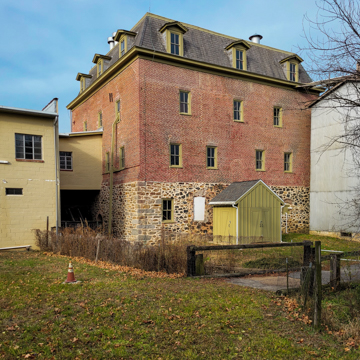Industry flourished early along this stretch of Christina Creek. The boxy brick mill stands almost in sight of the Cooch House ( PR3). Upstream from that house once stood Lord Keith's iron smelting furnace and drop hammer mill (c. 1720), the dam for which was raised in 1792 and restored after damage by Hurricane Floyd in 1999 by Landmark Engineering, Inc. Ruins of several other eighteenth-century mills still exist, and a barn just east of Cooch's Bridge with a datestone of 1792 in the foundation incorporates one wall from William Cooch Jr.'s grist mill. The 2,700-foot mill race of 1792 can still be traced, as well as the 1,300-footlong extension of 1822, elevated above the surrounding fields. It fed Dayatt Mill, built by Cooch but expanded following its purchase by John Dayett in 1894. Dayett (locally pronounced “diet”) added boilers and engines to supplement waterpower and could grind seventy-five barrels of flour per day here. The facility was restored after fires in 1916 and 1933. In 1981, it was one of only two mills in the state still in operation (the other was Hearns Mill, Seaford) and used a water turbine of 1918. Subsequently abandoned, Dayatt is undergoing long-term restoration.
You are here
Cooch-Dayett Mill
c. 1822; c. 1894 enlarged, with later changes. Dayett Mill Rd., 0.2 miles southwest of intersection of Old Baltimore Pike and DE 72
If SAH Archipedia has been useful to you, please consider supporting it.
SAH Archipedia tells the story of the United States through its buildings, landscapes, and cities. This freely available resource empowers the public with authoritative knowledge that deepens their understanding and appreciation of the built environment. But the Society of Architectural Historians, which created SAH Archipedia with University of Virginia Press, needs your support to maintain the high-caliber research, writing, photography, cartography, editing, design, and programming that make SAH Archipedia a trusted online resource available to all who value the history of place, heritage tourism, and learning.


